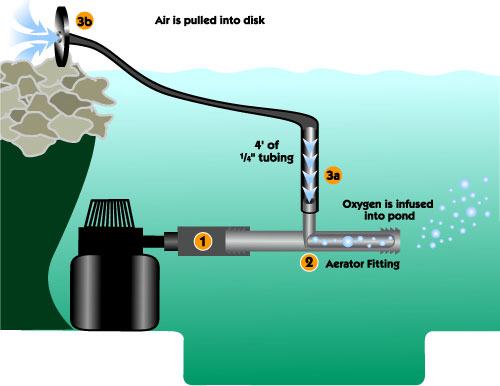Winter Aerator Installation
The aerator is an important product that will allow gas exchange and will supply the necessary oxygen for fish to survive through the winter.
Aerator Install - attached to pump (see illustration below)
Raise your pump up from the bottom of the pond to a level just below the water’s anticipated ice depth. This pump placement for the winter will circulate only the cold water close to the surface, not the warmer water below.
Attach a small length of tubing (4” to 5”) to the pump’s discharge fitting as shown in illustration.
Insert the aerator fitting (hose barb) into the tubing making sure the flow arrow (shown on the bottom of the aerator fitting) is installed and pointed in the direction of the flow. Direct the water flow away from the fish. Cold water will transfer oxygen to all areas of the pond.
(a.) Attach the small 1/4" tubing to the small nipple on top of the aerator and then to the floating disk. (b.) Set the disc dial to full open and drape it over the pond’s edge.

-
It is perfectly fine if the pond freezes over, as long as the aerator is injecting air below the ice. Gas exchange will occur because the air will escape around and along the pond’s edge. The ice will protect the fish and at the same time insulate the water from the extreme fluctuations of air temperature.
- You may want to purchase a cattle trough heater to be placed in the deepest part of the pond. We don’t recommend the floating type heater. The heater needs to be plugged in only during extreme cold temperatures . . . temperatures that are well below zero, anticipated to last a week or longer. When temperatures are above zero, unplug the heater. This on and off procedure only controls the thickness of the ice formation.
- If you need to replace a pump or check the ice depth . . . use hot water to melt a hole in the ice . . . never break the ice... The percussion will stress the fish and cause inner ear damage.